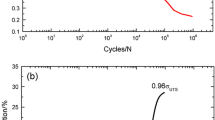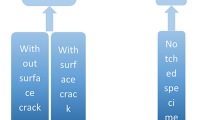Abstract
This fracture study evaluates the role of a fiber/matrix interfacial glass on the toughening of two different carbon/carbon (C/C) composites. Both composites incorporate a two-dimensional layup of 8-harness satin weave continuous fiber fabric, but differ in several aspects, the most significant of which is the presence of an oxidation inhibitor in one of these. The fracture behavior of both materials was determined in three-point flexure at 20 through 1650 °C. Microstructural studies indicate that the nonhomogeneous distribution of the oxidation inhibitor within the fiber bundles controls the fracture behavior. Electron microprobe results indicate a high concentration of the glass oxidation inhibitor associated with the inter-bundle matrix, while the intra-bundle matrix is composed primarily of carbon. Accordingly, debonding along the inter-bundle interfaces characterizes the oxidation inhibited composite, whereas the nonoxidation inhibited samples debond by individual fibers. Both materials exhibit strongly rising R-curves throughout the test temperature range. At the higher test temperatures the oxidation inhibited C/C shows the greatest cumulative toughening component, although at a lower value of the fracture toughness. This is consistent with the observed increase in the percentage of fibers that experience individual pullout at the higher temperatures.
Similar content being viewed by others
References
S. Awashi and J.L. Wood, Ceram. Eng. Sci. Proc. 9 (7–8), 553 (1988).
D.W. McKee, Carbon 25, 551 (1987).
S. Senet, R. E. Grimes, D. L. Hunn, and K. W. White, J. Mater. Sci. (in press).
S. Senet, R. E. Grimes, D. L. Hunn, and K. W. White, Carbon 7, 1039 (1991).
R. E. Grimes and K. W. White, Mechanics and Mechanisms of Damage in Composites and Multi-Materials, ESIS11, edited by D. Baptiste (Mechanical Engineering Publications, London, 1991), pp. 33–44.
S. Ochiai and P. W. M. Peters, J. Mater. Sci. 17, 417 (1982).
M.G. Jenkins, A.S. Kobayashi, K.W. White, and R.C. Bradt, J. Am. Ceram. Soc. 70 (6), 393 (1987).
E. Fitzer, W. Huttner, and L. M. Manocha, Carbon 18, 291 (1980).
A.L. Highsmith and K.L. Reifsnider, ASTM STP 775, 103 (1982).
K. W. White, R. C. Bradt, and A. S. Kobayashi, Proc. 7th Int. Conf. on Fracture, edited by K. Salama, K. Ravi-Chander, D. M. R. Tapun, and P. Rama Rao (Pergamon Press, Houston, TX, March 1989).
D. Wastein, J. Am. Concrete Inst. 43 (9), 1041 (1947).
R. C. De Vekey and R. J. Majumdar, Mag. Concrete Res. 20, 229 (1968).
L.B. Greszczuk, ASTM STP 452, 42 (1969).
P. Lawrence, J. Mater. Sci. 7, 1 (1972).
K.M. Prewo and J.J. Brennan, J. Mater. Sci. 15 (2), 463 (1980).
P.F. Becher and G.C. Wei, J. Am. Ceram. Soc. 67 (12), C267 (1984).
P. F. Becher, T. N. Tiegs, J. C. Ogle, and W. H. Warwick, Fracture Mechanics of Ceramics, edited by R. C. Bradt et al., 7, 61 (1986).
G. C. Wei and P. F. Becher, Am. Ceram. Soc. Bull. 3 (2), 298 (1985).
D. B. Marshall, B. N. Cox, and A. G. Evans, Acta Metall. 33 (11), 2013 (1985).
A. G. Evans and K.T. Faber, J. Am. Ceram. Soc. 67 (4), 225 (1984).
S. Bar-Ziv and D.G. Brandon, Ceram. Eng. Sci. Proc. 9 (7–8), 777 (1988).
C-H. Hsueh, P. F. Becher, and P. Angelini, J. Am. Ceram. Soc. 71 (11), 929 (1988).
A. G. Evans, J. Am. Ceram. Soc. 73 (2), 187 (1990).
R. W. Hertzberg, Deformation and Fracture Mechanics of Engineering Materials (J. Wiley and Sons, New York, 1976).
M. G. Jenkins, A. S. Kobayashi, K. W. White, and R. C. Bradt, Int. J. Fract. 34, 281 (1987).
K.W. White and L-P. Guazzone, J. Am. Ceram. Soc. 74 (9), 2280 (1991).
J. Chlopek and S. Blzewicz, Carbon 29 (2), 127 (1991).
L.E. Jones and P.A. Thrower, Carbon 29 (2), 251 (1991).
Author information
Authors and Affiliations
Rights and permissions
About this article
Cite this article
Lucchesi, A.J., Hay, J.C. & White, K.W. The influence of an oxidation inhibitor on the elevated temperature fracture resistance of carbon/carbon composites. Journal of Materials Research 7, 1795–1804 (1992). https://doi.org/10.1557/JMR.1992.1795
Received:
Accepted:
Published:
Issue Date:
DOI: https://doi.org/10.1557/JMR.1992.1795




